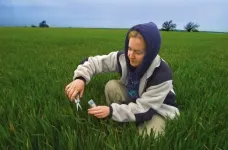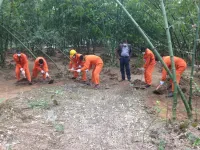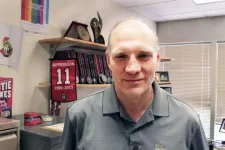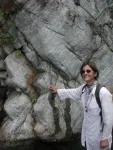(Press-News.org) As the story goes, the Greek mathematician and tinkerer Archimedes came across an invention while traveling through ancient Egypt that would later bear his name. It was a machine consisting of a screw housed inside a hollow tube that trapped and drew water upon rotation. Now, researchers led by Stanford University physicist Benjamin Lev have developed a quantum version of Archimedes' screw that, instead of water, hauls fragile collections of gas atoms to higher and higher energy states without collapsing. Their discovery is detailed in a paper published Jan. 14 in Science.
"My expectation for our system was that the stability of the gas would only shift a little," said Lev, who is an associate professor of applied physics and of physics in the School of Humanities and Sciences at Stanford. "I did not expect that I would see a dramatic, complete stabilization of it. That was beyond my wildest conception."
Along the way, the researchers also observed the development of scar states - extremely rare trajectories of particles in an otherwise chaotic quantum system in which the particles repeatedly retrace their steps like tracks overlapping in the woods. Scar states are of particular interest because they may offer a protected refuge for information encoded in a quantum system. The existence of scar states within a quantum system with many interacting particles - known as a quantum many-body system - has only recently been confirmed. The Stanford experiment is the first example of the scar state in a many-body quantum gas and only the second ever real-world sighting of the phenomenon.
Super and stable
Lev specializes in experiments that extend our understanding of how different parts of a quantum many-body system settle into the same temperature or thermal equilibrium. This is an exciting area of investigation because resisting this so-called "thermalization" is key to creating stable quantum systems that could power new technologies, such as quantum computers.
In this experiment, the team explored what would happen if they tweaked a very unusual many-body experimental system, called a super Tonks-Girardeau gas. These are highly excited one-dimensional quantum gases - atoms in a gaseous state that are confined to a single line of movement - that have been tuned in such a way that their atoms develop extremely strong attractive forces to one another. What's super about them is that, even under extreme forces, they theoretically should not collapse into a ball-like mass (like normal attractive gases will). However, in practice, they do collapse because of experimental imperfections. Lev, who has a penchant for the strongly magnetic element dysprosium, wondered what would happen if he and his students created a super Tonks-Girardeau gas with dysprosium atoms and altered their magnetic orientations 'just so.' Perhaps they would resist collapse just a little bit better than nonmagnetic gases?
"The magnetic interactions we were able to add were very weak compared to the attractive interactions already present in the gas. So, our expectations were that not much would change. We thought it would still collapse, just not quite so readily." said Lev, who is also a member of Stanford Ginzton Lab and Q-FARM. "Wow, were we wrong."
Their dysprosium variation ended up producing a super Tonks-Girardeau gas that remained stable no matter what. The researchers flipped the atomic gas between the attractive and repulsive conditions, elevating or "screwing" the system to higher and higher energy states, but the atoms still didn't collapse.
Building from the foundation
While there are no immediate practical applications of their discovery, the Lev lab and their colleagues are developing the science necessary to power that quantum technology revolution that many predict is coming. For now, said Lev, the physics of quantum many-body systems out of equilibrium remain consistently surprising.
"There's no textbook yet on the shelf that you can pull off to tell you how to build your own quantum factory," he said. "If you compare quantum science to where we were when we discovered what we needed to know to build chemical plants, say, it's like we're doing the late 19th-century work right now."
These researchers are only beginning to examine the many questions they have about their quantum Archimedes' screw, including how to mathematically describe these scar states and if the system does thermalize - which it must eventually - how it goes about doing that. More immediately, they plan to measure the momentum of the atoms in the scar states to begin to develop a solid theory about why their system behaves the way it does.
The results of this experiment were so unanticipated that Lev says he can't strongly predict what new knowledge will come from deeper inspection of the quantum Archimedes' screw. But that, he points out, is perhaps experimentalism at its best.
"This is one of the few times in my life where I've actually worked on an experiment that was truly experimental and not a demonstration of existing theory. I didn't know what the answer would be beforehand," said Lev. "Then we found something that was truly new and unexpected and that makes me say, 'Yay experimentalists!'"
INFORMATION:
Additional Stanford authors are graduate students Wil Kao (co-lead author), Kuan-Yu Li (co-lead author) and Kuan-Yu Lin. A professor from CUNY College of Staten Island and CUNY, New York, is also a co-author. Lev is also a member of Stanford Bio-X.
This research was funded by the National Science Foundation, Air Force Office of Scientific Research, Natural Sciences and Engineering Research Council of Canada and the Olympiad Scholarship from the Taiwan Ministry of Education.
If you asked people which group of animals is the most abundant on earth, hardly anyone would know the right answer. Ants? Fish? No, and not humans either. The answer is nematodes, also known as roundworms. Four out of five animals on earth belong to this group, and the reason hardly anyone is aware of the fact is that they live underground, invisible to us. Together with thousands of other soil organisms, they quietly, discreetly and constantly perform enormously important services for the world above them.
The soil is one of the most species-rich habitats in existence. Living under one square meter ...
The human body is like a construction site where hundreds of thousands of different molecular nanomachines, called proteins, are simultaneously at work. Each one of these biomolecules, which are chains of amino acids essential to living organisms, perform a different biological function, often in synergy with other proteins. During their formation (the folding process) or in the performance of their biological functions, proteins change their shape in a very specific way. In many cases it is possible to conduct experiments that provide images of proteins at near atomic resolution, but only when they are in the stable and biologically ...
New research from CU Cancer Center member Jing Hong Wang, MD, PhD, and recent University of Colorado Immunology program graduate Rachel Woolaver, PhD, may help researchers develop more effective personalized immunotherapy for cancer patients.
Working within Wang's specialty of cancer immunology and head and neck squamous cell carcinomas (HNSCCs), the researchers worked to establish a mouse model that would help them understand why some hosts' immune systems reject tumors easily, while others have a harder time doing so. Their research was published last week in the Journal for ImmunoTherapy of Cancer.
"It's particularly interesting now because the field of cancer treatment has really been going in the direction of immunotherapy, ...
Researchers at the UC Davis Violence Prevention Research Program (VPRP) assessed the prevalence of exposure to violence, such as robbery or assault, and its impacts on the mental health and social functioning of California adults. Their study, published in the Journal of Interpersonal Violence, shows the far-reaching psychological effects an incident of gun violence can have on victims and those close to them.
The study's findings are based on data from 2,558 adults who responded to the 2018 California Safety and Wellbeing Survey (CSaWS). CSaWS is an ongoing survey research project on firearm ownership and the consequences of exposure to violence in California. Responses were weighted to be statistically representative of the state's adult population.
These ...
Primer on Carbon Dioxide Removal Provides Vital Resource at Critical Time
--By Julie Chao
Scientists say that any serious plan to address climate change should include carbon dioxide removal (CDR) technologies and policies, which makes the newly launched CDR Primer an especially vital resource, says Berkeley Lab scientist Margaret Torn, one of about three dozen scientists who contributed to this document.
"Atmospheric CO2 concentrations are already 50% over historic natural levels - 270 ppm (parts per million) in pre-industrial times vs 414 ppm today," said Torn. "To slow climate change and avoid its worst impacts, climate scientists tell ...
MADISON, Wis. -- As a new, apparently more transmissible version of the virus that causes COVID-19 has appeared in several countries, new research finds that the transmissibility of viral strains and the population density of a region will play big roles in how vaccination campaigns can help towns and cities return to more normal activities.
The findings suggest that directing vaccines toward densely populated counties would help to interrupt transmission of the disease. Current vaccination distribution plans don't take density into account.
Tony Ives at the University of Wisconsin-Madison and Claudio Bozzuto of the independent data research company Wildlife ...
Researchers from the University of Cambridge, the University of Milan and Google Research have used machine learning techniques to predict how proteins, particularly those implicated in neurological diseases, completely change their shapes in a matter of microseconds.
They found that when amyloid beta, a key protein implicated in Alzheimer's disease, adopts a highly disordered shape, it actually becomes less likely to stick together and form the toxic clusters which lead to the death of brain cells.
The results, reported in the journal Nature Computational Science, could aid in the future development of treatments ...
Decades after the industrialized world largely eliminated lead poisoning in children, the potent neurotoxin still lurks in one in three children globally. A new study in Bangladesh by researchers at Stanford University and other institutions finds that a relatively affordable remediation process can almost entirely remove lead left behind by unregulated battery recycling - an industry responsible for much of the lead soil contamination in poor and middle-income countries - and raises troubling questions about how to effectively eliminate the poison from children's bodies.
"Once the lead is in the environment, it stays there pretty much indefinitely ...
A new University of Saskatchewan (USask) study has found that stretching is superior to brisk walking for reducing blood pressure in people with high blood pressure or who are at risk of developing elevated blood pressure levels.
Walking has long been the prescription of choice for physicians trying to help their patients bring down their blood pressure. High blood pressure (hypertension) is a leading risk factor for cardiovascular disease and among the top preventable risk factors affecting overall mortality.
This new finding, published December 18, 2020 in the Journal of Physical Activity ...
On a beach on a remote island in eastern Papua New Guinea, a country located in the southwestern Pacific to the north of Australia, garnet sand reveals an important geologic discovery. Similar to messages in bottles that have traveled across the oceans, sediments derived from the erosion of rocks carry information from another time and place. In this case the grains of garnet sand reveal a story of traveling from the surface to deep into the Earth (~75 miles), and then returning to the surface before ending up on a beach as sand grains. Over the course of this geologic journey, the rock type changed as some minerals were changed, and other materials were included (trapped) within the newly formed garnets. The story is preserved ...



